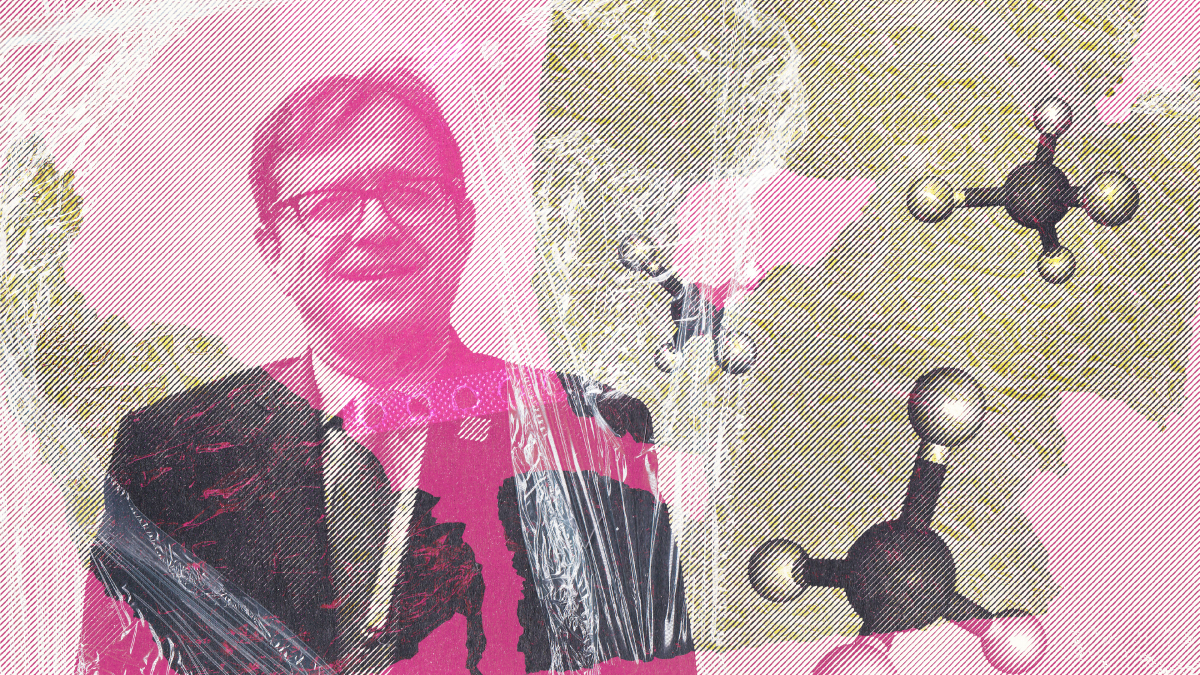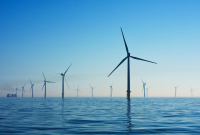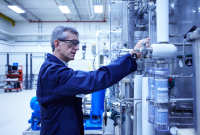Support strong Canadian climate journalism for 2025
In Jonathan Wilkinson’s ideal future, Canada is home to a booming hydrogen industry.
Decades from now, the natural resources minister and his government want hydrogen to generate electricity, power vehicles, heat buildings and play a part in cleaning up heavy-polluting industries like steel making. Specialized ships will dock at ports in Halifax, Montreal and Vancouver to load up on made-in-Canada liquid hydrogen, destined for European and Asian markets.
While that may be on the horizon, it’s a long way off and far from certain. In the short term, Canada is focused on executing Step 1 of its grand energy strategy — facilitating the construction of export terminals to ship liquefied natural gas (LNG) overseas. The federal government says that will eventually lead to Step 2, when one day, that infrastructure will ship hydrogen as well.
This was the future Wilkinson’s team was pushing in meetings with international counterparts at last year's COP26 climate conference, briefing materials received through a federal access-to-information request by Canada’s National Observer show — one that included both Canadian LNG and an entire vision for Canada’s role in a global hydrogen market expected to be worth nearly $12 trillion by 2050.
For Canada to secure its place in the future hydrogen market, it is maintaining fossil fuels as the centrepiece of its strategy today. Its hydrogen strategy, published in late 2020, makes clear that while there is potential to produce hydrogen from renewable energy sources with zero greenhouse gas emissions, the short-term focus is to produce it from natural gas in concert with the fossil fuel sector.
As previously reported by Canada’s National Observer, Natural Resources Canada believes “Canada’s oil and gas sector is well-positioned to develop domestic hydrogen supply chains.” As of last summer, the department was interested in learning how “to persuade financial institutions to invest in blue hydrogen projects.”
Blue hydrogen refers to hydrogen made from methane — the main ingredient in natural gas — using technology to capture most, but not all, of the planet-warming carbon dioxide emissions this process creates. Green hydrogen is made exclusively with renewable energy and produces zero emissions.
Wilkinson’s director of communications Ian Cameron said the department isn’t focused on colours, it’s focused on emissions. Ottawa’s hydrogen strategy overwhelmingly refers to its plans as “clean hydrogen” without distinguishing between green and blue.
“The talk in Canada is to use the euphemism of ‘clean hydrogen’ because Canada is not a low-cost jurisdiction to manufacture green hydrogen,” explained Paul Martin, a chemical engineer and co-founder of the Hydrogen Science Coalition.
“... What's going on is the fossil fuel industry, particularly the fossil gas industry and the people that distribute fossil gas for a living, are looking to stay in the energy business.”
Canada’s strategy is to grow a hydrogen industry at home until there is global demand. At that point, it will want to crank up exports. However, there are two massive problems on this front. One is that while using natural gas is currently the cheapest way to produce hydrogen, the International Energy Agency expects the cost of green hydrogen to fall substantially this decade to the point where it will be cheaper to produce hydrogen using solar panels than natural gas. In other words, to be successful, Canada’s blue hydrogen bet depends on the cost of renewable energy staying higher than the cost of natural gas.
The second problem is the markets Canada is eyeing in Europe are an ocean away and require specialized export terminals, ships and other infrastructure to reach, adding to the cost of Canada’s hydrogen strategy and the risk this infrastructure could one day become worthless as the world quits fossil fuels in favour of renewable energy. Taken together, the risk is Canada’s hydrogen made from natural gas could be more polluting and more expensive to produce and deliver to market than the green hydrogen options that may be available elsewhere.
Germany factors heavily into Canada’s plans because it has significant demand for natural gas and is also untangling itself from Russia, which supplied about half of its demand prior to the invasion of Ukraine. Because of the war — and the implied threat that gas supplies could be entirely cut off — Germany is in a full-blown energy crisis and is looking to secure new supplies of natural gas for the short term while holding onto a longer-term goal of ditching fossil fuels for power by 2035. To do this, it wants any new LNG infrastructure to eventually be able to handle cleaner fuels like liquid hydrogen. Germany prefers green hydrogen over blue, although briefing materials suggest that, like Canada, its first priority is simply growing a hydrogen market.
Wilkinson was not made available for an interview, but in a speech to the Regina & District and Saskatchewan chambers of commerce last month, the natural resources minister said: “As a nation, as a people, surely, we can walk and chew gum at the same time. We can help our European friends in the short term and achieve our ambitious and vital climate goals.”
It’s clear that producing fossil fuels over the coming decades is still firmly in Canada’s plans. Over the next 30 years, fossil fuels will still be burned, and even beyond 2050, “countries that focus on producing hydrocarbons with ultra-low production emissions are likely to be the last producers standing,” Wilkinson said.
The key to Canada’s grand bargain with its fossil fuel sector is carbon capture technology, which to date has failed to live up to its promise. However, if this technology is someday successfully implemented, it could open up market opportunities for hydrogen made from natural gas. In this calculation, the fossil fuel industry would not need to be phased out, it would simply need to transition. But even if the technology captures an ambitious 90 per cent of carbon dioxide emissions someday (the target outlined in the hydrogen strategy), the remaining 10 per cent that reaches the atmosphere would still contribute to global warming.
This plan to continue investing in the fossil fuel sector’s future was on full display at COP26 when Quebec joined the Beyond Oil and Gas Alliance (BOGA), a coalition led by Denmark and Costa Rica that seeks to phase out fossil fuels around the world. Canada refused to sign on.
“This initiative is not in Canada’s interest, as its aim to phase out the oil and gas sector conflicts with Canadian policy ensuring the sector has a sustainable role in a net-zero world,” reads a briefing note prepared for Natural Resources Canada staff ahead of a meeting with Denmark’s climate change ambassador Tomas Anker Christensen.
Fossil fuels are the top driver of climate breakdown, and the Intergovernmental Panel on Climate Change (IPCC) is clear: their use must be slashed dramatically this decade if there is any hope of keeping global warming as close to 1.5 C as possible. Fossil fuel production and consumption have to fall 30 per cent over the next eight years to align with the Paris Agreement’s 1.5 C target.
Briefing materials prepared for a meeting with European Union commissioner for energy Kadri Simson link LNG exports with hydrogen. Canada wanted to pitch the EU on Canadian LNG but the briefing note acknowledges the EU “may not fully understand the alignment with Canada’s Hydrogen Strategy.”
Beyond the briefing materials, reusing LNG infrastructure is openly the plan in Canada’s hydrogen strategy and was recently reiterated by Prime Minister Justin Trudeau.
Martin said he laughed out loud when he first heard that was even being considered.
“It's so factually incorrect that it kind of drives you crazy to hear people say it,” he said.
Where to start with the problems? First, methane, the main ingredient of natural gas, and hydrogen are not the same. They have different densities, and it takes different amounts of energy to liquify the gas. To safely transport hydrogen through existing natural gas pipelines, the network would require upgraded piping and compressors. Then, when it gets to an export terminal, it needs different equipment and significantly more energy to cool it to a liquid than natural gas. Methane has to be cooled to -162 C before it turns to liquid, whereas hydrogen needs to be cooled to -249 C. It then needs specialized ships to transport it. Practically all of this means the infrastructure can’t be easily reused; it needs to be replaced, Martin said.
Moreover, hydrogen leaks more than natural gas without specialized infrastructure. Hydrogen is not a greenhouse gas, but when it reaches the atmosphere, it interacts with other chemicals and slows the breakdown of methane, a greenhouse gas roughly 86 times more potent than carbon dioxide over a 20-year period. Extending the life of methane in the atmosphere contributes to global warming.
Last year, the IPCC specifically highlighted methane pollution reduction as an important short-term priority for the world to keep its grip on a climate-safe future.






Comments
Remember clean coal? Now it's clean gas, clean hydrogen, clean nuclear, clean, clean, clean.
The GoC has been wooed by hydrogen advocates for decades, and their own scientists pushed back for esoteric reasons such as "thermodynamics." Ministers and aides should spend more time talking to impartial engineers and chemists. Surely NRCan still employs these honest, competent experts.
Thermodynamics is not "esoteric". It's a very relevant branch of physics that studies energy transfers. The three laws can be summed up as "you can't win, you can't break even, you can't quit the game". Notably, it puts an end to claims of limitless energy sources and perpetual motion machines. I'm glad to hear about reality checks on industry ballyhoo.
But they're not likely to provide much by way of campaign contributions, are they?
"Research results have shown that using pipelines designed for natural gas conduction to transport hydrogen is a risky choice". Why? - because the intrusion of hydrogen into the steel of natgas pipelines causes significant embrittlement of the pipe.
Source: (Sandia National Laboratories, 2019) , “Hydrogen Effects on Pipeline Steels and Blending into Natural Gas”. https://www.osti.gov/servlets/purl/1646101
You'd think the minister would know this stuff, or be advised of scientific and engineering facts before the Cloud Nine rhetoric kicks in. The stated policy was dreamt up by PR flacks purely for political propaganda purposes. There isn't a shred of scientific literacy in it anywhere and it is merely a way to avoid the heavy lifting of regulating industry towards a genuine transition (a word bandied about cavalierly in a vacuum of real transition planning) and owning up to the embarrassing fact that at least three of our federal parties have invested in the continuance of producing new fossil fuel projects and enhancing the existing with other pipe dreams like CCS.
Just Have A Think did a very informative video on just this topic last year. Dave Borlace refers to a peer reviewed engineering study on Blue Hydrogen that shatters all the illusions industry has built around it. And it does it with evidence and checkable facts.
https://www.youtube.com/watch?v=2EA4tDYwNYo
If deep geothermal power with direct connections to the grid was explored with as much public and private money and political capital, one could be forgiven to quickly conclude that it has the capacity to clean the carbon clock at a cheaper cost and with thousands of new jobs created in the process.
That is not entirely true.
The problem is only with old school “hard steel” pipelines. Newer pipelines are made of “soft steel” is fine for hydrogen transport. A majority of pipelines in US Gulf Coast are already ready for this. And 90% of European pipelines are ready for hydrogen transport.
For hard steel pipelines, cheaper fixes exist, such as spraying chemical coating, or inserting a liner of plastic etc to resolve the issue. UK has successfully tested this last year.
"In Jonathan Wilkinson’s ideal future, Canada is home to a booming hydrogen industry. … Specialized ships will dock at ports in Halifax, Montreal and Vancouver to load up on made-in-Canada liquid hydrogen, destined for European and Asian markets."
Wilkinson’s fantasies about carbon capture, SMRs, and blue hydrogen sound the death-knell of science-based climate policy in Canada.
Canada wants to "green" (i.e., greenwash) its fossil fuels, not get off them.
In the oilsands, "net-zero" by 2050 depends on an unholy triad of white elephants: SMRs, blue hydrogen, and carbon capture and storage.
The oilsands industry plans to use blue hydrogen (instead of natural gas) to reduce upstream emissions in bitumen production. Which does nothing to reduce downstream emissions at the consumer end.
The push for nuclear power, carbon capture, and blue hydrogen is a delaying tactic. A lifeline for Canada's O&G industry.
"Canada has big plans to use hydrogen to cut emissions - and produce more oil" (Reuters, Sep 4, 2020)
https://www.reuters.com/article/us-canada-hydrogen-idUSKBN25V1KL
"Blue" hydrogen perpetuates the fossil fuel industry and may generate even higher emissions:
"Biden-backed 'blue' hydrogen may pollute more than coal, study finds" (The Guardian, 12 Aug 2021)
"Study finds large emissions from production of 'blue' hydrogen"
https://www.theguardian.com/environment/2021/aug/12/clean-fuel-blue-hyd…
"Chair of UK hydrogen body quits over support for fossil-fuel dependent 'blue hydrogen' championed by Tories" (The Independent, Aug 19, 2021)
https://www.independent.co.uk/climate-change/news/blue-hydrogen-associa…
"The chair of the UK Hydrogen and Fuel Cell Association (UK HFCA) has quit, saying he cannot support the body's support for so-called 'blue hydrogen', which scientists have warned could not only boost emissions of GHGs but also 'lock in' dependency on them.
"He described the technology as 'an expensive distraction' which could ultimately serve to undermine critical climate targets.
"'I believe passionately that I would be betraying future generations by remaining silent on that fact that blue hydrogen is at best an expensive distraction, and at worst a lock-in for continued fossil fuel use that guarantees we will fail to meet our decarbonisation goals.'
"His comments come after research released this month by academics at Cornell and Stanford universities warned that the blue hydrogen process could generate 20% more emissions over its life cycle than burning the natural gas in the first instance – and possibly even more."
*
"The 'Big Lie' of Blue Hydrogen Starts With Ignoring Basic Economics" (Desmog)
https://www.desmog.com/2021/09/10/the-big-lie-of-blue-hydrogen-starts-w…
"Federal watchdog warns Canada's 2030 emissions target may not be achievable" (CBC, Apr 26, 2022)
"The commissioner, Jerry DeMarco, released a series of audits today that document the federal govt's environment-related shortcomings...
"But DeMarco was perhaps most scathing in his assessment of the govt's hydrogen strategy, which he said is based on 'overly optimistic' assumptions that 'compromise the credibility' of the govt's entire emissions reduction plan.
https://www.cbc.ca/news/politics/environment-commissioner-emissions-red…
"Europe's Current Energy Crisis Was Predictable — And Was Predicted' (Clean Technica, 7-Oct-21)
https://cleantechnica.com/2021/10/07/europes-current-energy-crisis-was-…
"…Brussels and the European parliaments should be rethinking their power grids and hydrogen pipe dreams, and refocusing on actual solutions to the climate crisis. Canada should be backing away from its blue-tainted hydrogen policy, and pivoting to one that's actually green."
Hydrogen is difficult to transport and export. Green hydrogen manufactured by electrolysis of water can be manufactured locally. No imports or exports required.
Green hydrogen will eventually be produced at lower cost locally around the world from water via electrolysis powered by renewables.
For reasons of energy density, safety, and ease of transport, it won't make economic sense to export significant volumes of hydrogen.
The 'Big Lie' report is certainly doing the rounds these days.
If I recall rightly it was Gabriel Garcia Marquez’s novel One Hundred Years of Solitude where the fictional community forgot the names of things—I think right around the time a huckster arrived to promote a gold detecting contraption (that ultimately proved a failure). In the end, people had to affix labels onto donkeys, cattle, wagons and everything else in order to communicate —by indication—with each other.
I’m reminded of this fantastic satire by the current obsession with the domains of names for energy, the stuff we get much of from fossil fuels—the stuff that’s killing the biosphere on which we and all life depend.
The compulsion to sugar-coat, diminish and deceive is some kind of function between need and greed: plainly we don’t need a dead planet, rather we need to stop killing it. But our fatal addiction isn’t entirely the utility of carboniferous muskeg, rock, and petroleums (peat, coal, oil, natural gases, bitumen and asphalt), but its profitability—that is, so long’s the costs of air, water, and land pollution are not paid by the industries otherwise profiting from the extraction, transporting, refining and sale of the goo, as well as the massive auxiliary manufactories of requisite machinery and consumer products like plastics. Citizens grumble at a carbon tax that’s nothing more than a ticket to oblivion, only by a slightly slower route. Then profiteers rage. Then, like guitarist Albert King used to say, everybody gets the blues; some people calls them the greens or the dirties, but sooner or later everybody has the blues. Albert cleaned up with “Blues Power.”
The ‘sunny days’ promised ahead also means different things to different people. Some envision a return to a natural balance, others would be okay with a half- over a full-dystopic world. The petroleum industry talks glowingly of sequestration of its product’s problematic byproducts— carbon-dioxide and coincidental methane—a happy-ending technology for when the petro-industry doesn’t have to worry about paying for the ecological costs of burning their goo into the atmosphere because, presto, they will capture it—but beware of asking where they’ll put it: it’s a real rabbit hole. The critical timeframes are so fuzzy that current underachievement can hardly be measured except maybe in terms of when nations commit to reducing ongoing emissions to some level it used to be during the past 200 years that we’ve been detrimentally exhausting petro-fuel combustion into the air. It’s just really hard to put a name to something that ethereal.
But we’re all down with “clean” this and “green” that. “X% Less Y (plastic, oil, human exploitation, ecological degradation)” we see advertised on a growing number of consumer products is obviously a shell and pea game.
“Clean hydrogen” is euphemism for perpetuation of “dirty oil”—itself a kind term for bitumen, the production of which is very dirty because it has to be cooked out of its largest sandy deposits in the world, Alberta and Saskatchewan, and fossil-fuels fuel the smelting/distillation process, almost doubling the greenhouse-gas emission of a comparable unit of conventional oil. We’re not supposed to say “tar sands” but, rather, “oil sands,” even though bitumen is neither: it’s the “dirty” procurement method that stigmatizes. The simple solution, in nomenclature and mass-psychology terms, is to label everything with “clean” until it is as attractive and meaningless as “new and improved!”
Even bitumen is trying to get in on the blue or “clean” hydrogen game—although perhaps with the help of small, modular reactors (whose nuclear waste is as clean as their larger, permanently located nuclear power plants). No worries: after all, we do have clean radiation—medical X-rays, watch-faces, smoke detectors and immortal tetrapack milk—as in, “safe as…”
The fact is that no single thing replaces oil’s convenience in being liquid in the same temperature range as human viability; but every technological answer to fossil fuels which aren’t quite so convenient (distilling bitumen out of sand, compressing combustible petro-gases, sequestering carbon, &c) costs the environment even more.
“Blue hydrogen” is a dodge because industry keeps profiting from the eventual combustion of GHGs into the atmosphere with minimal —or token—costs usually enthused as ‘promising research.’ Is it “clean,” “green,” or “dirty” research? One thing’s apparent: naming, at least, seems “sustainable.”
We are swamped in bogus nomenclature. If it keeps accumulating, it will eventually compresses into phases of petrofication. Some future race—possibly little green or clean men from space—might discover and harness the accumulated bounty of millions of years and perhaps even initiate a new round of euphemistic naming when its toxic concentrations can’t be feasibly diluted by the commons. Perhaps “magic” will become the by-word in a world that’s no longer clean or green.
In the Biblical Genesis story, back when the world was green, God brings Adam all the animals to find out what he will name them, yet no mate could be found among them for blue Adam. A technological solution was found (clonal gender-transitioning) and increase profitably increased, but even the name “naming” appears to have been euphemistic: in this case it seems to mean mating with something less bestial than the teeming life forms that crawled upon the green earth, flew in the blue sky, and swam in the clean ocean.
How’s about “earth hydrogen,” or “sky hydrogen”—or even “ocean hydrogen”…? Too arcane?
Clean hydrogen? “I yam what I yam…”
Stick to the facts Geoff - you're no a satirist.
Has anyone noticed a total silence in environmental groups, climate advocates, green activists, on the topic of green hydrogen? It is baffling… everyone complains of fossils, everyone suggests solar, wind, batteries, electric grids. Period. That is where the list of solutions stops.
The keystone issue in these solutions is long term energy storage, something longer than 8-16 hours. Something that can store energy across seasons.
NATIONAL GRIDS are a solution, but expansion will take decades.
NUCLEAR PLANTS are a solution, but will take about a decade, if we start now and assume that there will not be protests regarding dumping of nuclear waste.
GREEN HYDROGEN is a solution that is possible to scale within just 3-4 years.
The only opposition we hear for green hydrogen is from fossil fuel lobbies and enthusiasts. And that lone argument has also been busted now, with the US Climate Bill passing a $3/kg production tax credit last week. This is a defining moment as it will bring green hydrogen cost at par with dirty grey hydrogen…. Cheaper than blue hydrogen, even cheaper than diesel! Europe, Japan, Korea, China, Australia are already years ahead of Canada on green hydrogen.
Yet, we have no excitement, no news, nobody screaming for green hydrogen. What’s the matter?
CNO has barely one or two articles over the last two years, devoted to green hydrogen. Utterly disappointing, when a solution is staring us in the face.
Martin's concerns skip around the simple fact that quite a lot of the expense of an LNG terminal is not the machinery. Yes, that will have to be more replaced than upgraded (though that can be lessened by knowing, going in, it will soon be doing hydrogen, and designing appropriately).
But an LNG terminal is also
* the land acquired to build it; this often takes years and is more of the expense than you'd imagine
* the land must be sculpted into an LNG terminal's foundation
* the equipment all sits on tens of thousands of tonnes of concrete that must be laid down first, the vessels and machinery have foundations in thousands of tonnes of structural steel
* equipment that pressurizes gas with huge turbines does not last many decades; it has to be replaced ANYWAY, normally.
The "Hydrogen Strategy" is skipping over how expensive the conversion will be, to some extent, but to a greater extent, Martin is skipping over how much of the expense can indeed by defrayed by prior use for LNG.
Canada, by the way, is anything but expensive for the production of green hydrogen. Having over 80% of our own needs met by hydro and nuclear, we can afford to give away our copious wind energy; most of it just by shipping electrons over the border in cables, but when the Americans aren't buying, we might as well make hydrogen.
Also, if Proton Energies are not liars, and their tech works, Canada is going to be a fountain of green hydrogen out of the ground.